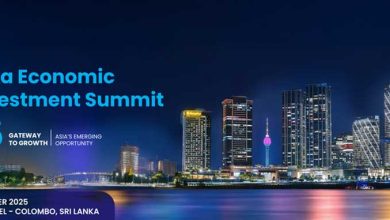LMDtv 3

Tariff wars, hikes and turbulence have rattled international trade for Sri Lanka – particularly with the US, after it imposed reciprocal taxes on imports. On a positive note however, with the tariff storm calming – albeit temporarily – Sri Lanka appears to be in a stable state for the time being.
According to the Group Managing Director of Brandix Lanka Hasitha Premaratne, Sri Lanka is in a “good bucket along with export peers such as Bangladesh, Pakistan, Vietnam and Cambodia.”
During a recent LMDtv interview, he explained that “the two big manufacturing giants are being taxed in the 50-55 percent range, countries like ours are in the 19-20 percent bracket and African nations find themselves in the 10-15 percent category.”
Premaratne elaborated: “The tariffs have put the world of manufacturing into three buckets, which is quite challenging from a supply chain perspective. When different countries have different tariff rates for different products, it’s not a level playing field.”
Though the US tariff on Sri Lankan exports was reduced from 44 to 20 percent following intense negotiations, the country needs to ensure that the rate is frozen at this point.
“Other countries are looking at negotiating their rates further and some may even get a better deal like 15 percent. Sri Lanka must also seek to improve its trade deal with the United States,” Premaratne noted.
He continued: “The tariff situation has paused a lot of investments into growth related initiatives because market dynamics are currently challenging, volatile and uncertain. Yet, we need to play in the short term and see how things move along. We should respond to some of these changes quickly and with a great deal of agility so that Sri Lanka can be ahead of the competition.”
Sri Lanka already had HS code based tariffs. So when you have another 20 percent on top of that, a substantial duty is being levied on your products, he noted, adding: “While this is currently shared between the manufacturer and buyer, over time it will also be shared by the end consumer and rest of the supply chain such as raw material producers.”
Meanwhile, since China and India are facing massive tariffs by the US, they are aggressively seeking buyers in other markets – notably in Europe and Asia.
Premaratne explained that “these countries cut their prices to seek orders from non-US markets. And with more countries looking at diversifying their exports to non-US markets, there’s far more supply – and more competition. This gives buyers the advantage of choice and it also creates a pricing challenge for exporters.”
What’s more, he emphasised that there’s still some concern about the tariff structures because they’re changing rapidly and in unpredictable ways.
This makes short-term profitability and survival a challenge, and pressures businesses to “create a sustainable model for pricing where the sharing between different parties in the value chain is fair and absorbable. It’s tough because the apparel industry doesn’t work on very high margins and therefore, can’t absorb all these tariffs,” he lamented.
With tariffs pushing buyers to seek price reductions, it has become imperative to reassess cost structures.
What’s needed are transformational rather than incremental cost reductions because the former will be more permanent, he recommended. “We need to address the waste generated by our industries and improve productivity so that we can stay competitive in this new tariff environment,” he asserted.
Premaratne noted that Sri Lanka’s primary competitive edge has always revolved around quality, reliability and sustainable business models – particularly its adherence to the environment social and governance (ESG) framework.
He concluded: “Sustainability is one of our differentiating factors as a manufacturing country; and we will continue to focus on the environment, social and governance aspects, and also go beyond compliance.”



